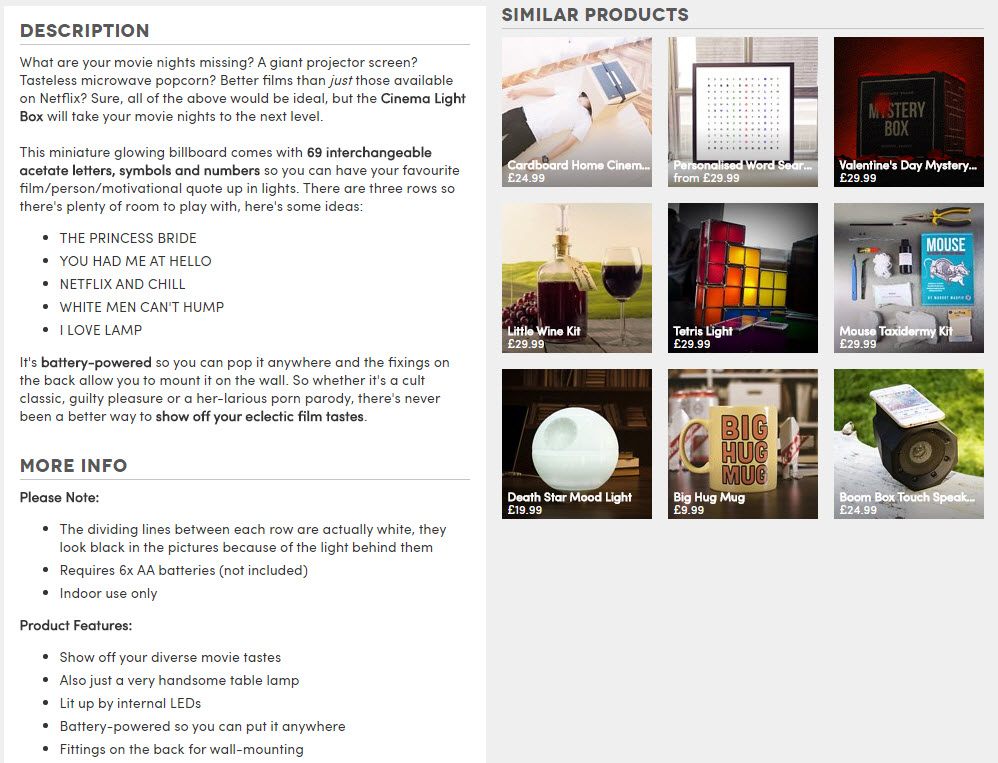Are you uninspired when it comes to writing product content?
Whether you are selling products through an e-commerce website, or displaying your products on your website without the facility to buy online, product content makes up some of the most important content on your site.
It does what it says on the tin!
If you sell services or products that are commodities or you think your products are ‘boring’, think again. It doesn’t matter what type of product or service you are selling. There are many things you can do to ensure your content is original and stands out from the competition.
Speaking of your competition, while it’s good to have a look at their content, don’t get too involved in this. Try looking at examples outside of your industry too.
In this post, I’ll discuss 10 useful tips for writing good product content.
1. Define your buyers
You’ve probably encountered the term ‘personas’ before. Before you write your product content, it’s essential that you research your buyer personas. Your buyer personas are effectively a generalised representation of your key customer groups.
You know your business and your customers and there is always room to do some research about your customer groups. Creating a detailed view of the customers that you are attempting to write content for is going to help you down the line.
Some benefits of buyer personas or profiles include:
- It means you can keep track of what is important
- You can set boundaries and a tone of voice
- All of your colleagues can get on board with the same message
- It can help to give each piece of content you write a purpose
2. Create a template
Think about your current and potential future product range and the type of information you need to display. If you are having a new website designed, or looking at improving your current site, this is an important consideration.
Of course, it’s not only the content that you have to think about when it comes to your product page layout, but it plays a big part of it and your product pages should aim to be consistent.
Read more about e-commerce product pages.
3. Make it easy to read
Speaking of templates, we know that people scan content online, so make it easy for them.
Allow for headings and bullet lists, and make good use of white space. Do not just include large paragraphs of text – they won’t persuade anyone to continuing reading.
4. Keyword research
Before you start writing, consider that you will need to optimise your product pages, so it would be wise to do some keyword research to find out what keywords you want to include in your content and ultimately, optimise each page for.
5. Product titles
Similar to blog post titles, the title of your product page is very important. It should be keyword focussed but most importantly, it should explain what the product is and be original.
Particularly if you are working with manufacturer products from suppliers, do not just use their product titles (or content for that matter), think of something original wherever possible.
The title of your page should be descriptive and easily identifiable to visitors.
6. Features and benefits
Or rather, benefits and features, because benefits are more important!
You need to weave any benefits or features of a product into the main content, but it may also be useful for the sake of scan-ability to summarise in a bullet point list.
Gift retailer Firebox do this to great effect on their website:

7. Specifications
Going back to point two again, hopefully you will have a suitable template for your product pages that can accommodate any specifications that you need to list.
How important are specifications? Do they need to have icons to make them recognisable?
For many products, specifications are featured at the bottom of a page. But if you are selling electronics, for example, specifications may be considered more important, so you might consider giving them more prominence.
Continuing from the previous example from firebox.com, after showing a list of features and benefits at the top of the page near the product image, they then include a persuasive description and more info, including any further specifications:

8. Be persuasive
This is the key part and often the most difficult.
Think about the reader or customer first: They don’t just want to know what your product is, they want to know what’s in it for them. Refer back to point one: who are you writing this for, and for what purpose?
How will your product make their life easier or more fun? What problem will it solve for them? How will it make them feel? Does the product have a sensory response that you can describe?
I could go on, but whatever your product, figure out what that benefit is and then start writing. Address a problem, need or desire and then persuade with a concise and well written description of the product and how it fits the bill.
Sometimes, addressing a problem may be that your product requires a detailed explanation of how it works or when it should be used. For example, if you sold spare parts for machinery, you may want to describe what signs to look for when the part needs replacing, before going on to highlight what the part does within the machine, and why it will benefit the customer.
Online retailer espares.co.uk take this approach with products such as vacuum filters and oven elements:

9. Use statistics
Back up your claims using statistics, facts and figures. For example, if your product is 25% cheaper than other leading brands, or conversely, if your product would provide a cost saving over a period of time, mention it!
Well known high-street retailer, Wilko, demonstrates this on products such as light bulbs:

10. Keep it concise, but not too short
But not too long, either. Let me explain…
It’s important to have a good amount of content on any page, product pages included, but the last thing you want is to have is empty content that doesn’t serve a purpose.
We know that Google is keen on monitoring ‘thin content’ at the moment.
“It feels like I am trying to hit 300 words of content for the sake of it”, I hear you cry.
Well it doesn’t always have to be that way, especially considering we are now writing unique, persuasive copy rather than a simple description of what a product is. Never write content for the sake of content, but using this guide, you could probably create lengthier product content that serves a purpose and makes you stand out from your competition.
The final step
To ensure all your hard work creating product content pays off, remember that social proof (reviews) and good product photography are important parts of the anatomy of your product page.
No matter what type of business you are, or if you have an e-commerce website or not, creating great product content is important. It helps improve SEO, it can provide better landing pages for paid advertising, and most of all, it gives your potential customers an improved overall experience.
Have you just learned something new?
Then join the 80,000 people who read our expert articles every month.





